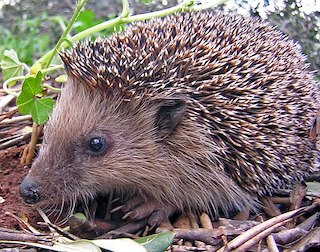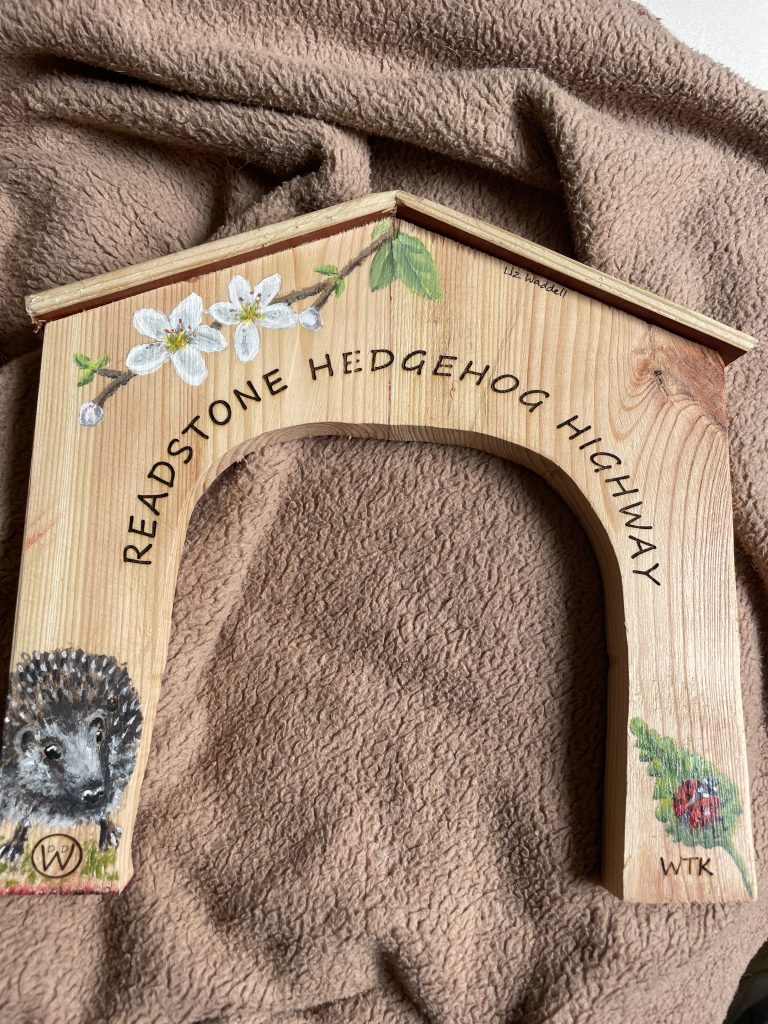Hedgehogs badly need our help; their numbers have fallen by up to 50% in the past twenty years.
Where do they live?
Hedgehogs thrive in hedgerows, fields and woodlands. They have also learnt to live alongside humans. Lots of gardens provide natural food and potential nest sites for sleeping, breeding and hibernation.

What do hedgehogs eat?
Be careful what you feed hedgehogs!
Avoid milk and bread as it upsets their stomachs. They eat anything small and catchable; slugs, beetles, snails, worms and caterpillars. They also eat seeds and herbs. Avoid whole peanuts, mealworms and sunflower hearts in ground bird feed.
The ideal food we can give for hedgehog’s is kibble – dried meaty dog food but be careful as adult kibble can get stuck in their gums and teeth. Wet cat food can also be given but can attract flies in hot weather. Always provide fresh drinking water. Use shallow heavy bowls for both water and kibble (old pate dishes are ideal for this). Check food and water every day when hedgehogs are out of hibernation. However, during hibernation still provide this as hedgehogs sometimes wakeup and need instant replenishment.
The best hedgehog feeding station is a clean, up-turned washing up bowl with a cut-out and something heavy on top to avoid it blowing away and being disturbed by other animals. Place this on a level surface in a quiet area with netting and fine grit underneath as this will deter slugs.
Hogs are messy eaters and may poo in the feeding area so this must be kept as clean as possible.
How can we help them survive?
Allowing them access between gardens is critical. Residents of our villages can help by creating ‘Hedgehog Highways’ through their garden fences. See the section on Hedgehog Highways.
In spring 2024 all the families at both of our primary schools were given a template to create a hedgehog hole in their garden fences along with a packet of wildflower seeds. We hope that there will be two Hedgehog Highways in the two villages. One on either side of the main road as we don’t want hedgehogs crossing it!
You can also:
Host a hedgehog house and feed station.
Boxes made from wood can be used for nesting and feeding in safety.
Build a Log Pile
These provide a safe site for breeding or hibernating as well as attracting insects for a year round supply of hedgehog food.
Create a Compost Heap
They are attractive nesting sites that also provide plentiful supplies of insects, worms and amphibians.
Other things to do:…
- Avoid using slug pellets, these are poisonous.
- Hedgehogs like untidy gardens; if you have the space leave a corner wild and unmanaged.
- Ponds can be dangerous. Leave a sloping area to allow the hedgehogs to climb in and out.
- Should you see a hedgehog in distress get in touch with a rescue centre. See at the end for contact details.
How to create a Hedgehog Highway
How to do this
Cut a D shape or square 5”x 5” hole in a wooden fence panel or remove the bottom brick from a brick wall. For wire fences, place a short section of pipe, 13 cm in diameter, at the bottom. You might also want to make a fancy hedgehog shaped door surround. See the picture…

Apparently hedgehogs follow things like walls and fences and if they get food and water they will keep coming back.
Talk to your neighbours and see if you can create a joined up trail through your gardens for hedgehogs to explore for food and nesting material.
See how the village of Keyworth in Nottinghamshire has attracted hedgehogs to their gardens https://www.bbc.co.uk/news/uk-england-nottinghamshire-63096303. See also You Tube, Keyworth Hedgehog Highway – Paul Stockham for a real hedgehog using the hedgehog trail.
Threats to hedgehogs
Sadly all man made, listed here in order of seriousness:
1. Lack of natural habitat and hedgehog highways leading to inter breeding and malnutrition leading to a decline in population.
2. High mortality rates from cars and other vehicles. Lack of under-pass provision.
3. Injury and death in our gardens due to strimmers, mowing, bonfires, nets and chemicals such as slug pellets.
4. Planners and builders with little regard for the needs of hedgehogs leading to local habitat loss e.g. boxed in garden fencing, cutting of mature trees and shrubs.
5. Being too tidy in the garden and laying plastic lawns.
6. Pets such as aggressive dogs can lead to stress in resident hogs. In fact they probably will discourage them – another habitat loss which means one less site for hedgehogs to live in.
Hedgehog Health
Signs of a healthy hedgehog.
- Bright eyes, wet nose, quick to run away or curl up when disturbed.
- A good healthy weight for an adult is between 500 grams or 1 pound to 1 kilo or 2.2 pounds. This also depends on season, sex and age. A hedgehog just before hibernation needs to be at least 600 grams to survive the winter, but the ideal weight is around 850 grams.
Hibernation is usually at the end of December in our area but this is dependant on the weather.
Signs of a sick hedgehog and illnesses
- Out during the middle of the day (foraging at dawn and dusk is normal).
- Circling/staggering or difficulties in walking.
- Lying on its side or sleeping in open areas such as your lawn.
- Flies around it or on it, check for fly strike (white fly eggs and maggots around the anus and wounds if any).
- Small hoglets out on their own constantly squeaking and weighing under 300 grams.
- A dehydrated listless hedgehog – you can see this if eyes and nose are dry and skin is loose when spines are gently pulled.
- Excessive infestation with ticks which can lead to severe anaemia.
- Coughing, sneezing and watery discharge from nose and eyes.
- If you see signs of obvious trauma please contact a rescue centre for further advice or the RSPCA.
Apart from injury illnesses cover 4 main areas:
1. Respiratory: pneumonia, objects caught in the throat.
2. Parasitic: lungworm infestation caught from infected snails. Fly strike, ticks and mites leading to anaemia and mange.
3. Fungal infections such as mange leading to loss of skin and spines
4. Poisoning from chemicals, especially those used in the garden e.g. slug pellets and weed killers.
To check a hedgehog’s health try, if you can, to weigh the hog on kitchen scales especially if dehydration or poor weight is suspected prior to hibernation.
Transportation of sick hedgehog
Gently place the sick hedgehog in a high sided box with a dry towel using gardening gloves.
Rescue centre details:
- Chorley contact: Katherine
Chorley Hedgehog Rescue – 07948 730855 between 8am – 10pm
- Preston contact:
Preston Hedgehog Rescue – 07590 583544 (Kirsty) 07500 338151 (Mark)
- Leyland contact:
Leyland Hedgehog Rehabilitation – 07732 245844
- Slaidburn:
Fuzzy Peg Rescue – contact via Facebook page
- Accrington contact:
Willow Top Hedgehog Rescue – 07792 106733
Other sources of information:
